BEAUTIFUL COLMAR – GATEWAY TO THE ALSACE
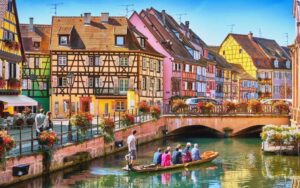
The charming town of Colmar is the ideal place to start exploring the so-called Route du Vin, and all the picturesque towns and villages of the Alsatian wine-growing region. It doesn’t get any prettier than Colmar, with its picturesque half-timbered houses, romantic canals, window boxes laden with bright flowers, a labyrinth of cobblestone lanes, and the delicious food and wine of the region.

Nestled among vineyards, Colmar is like something out of a Brothers Grimm fairytale, with narrow lanes, and pretty, pastel-coloured traditional houses lining the winding canal of the River Lauch around the Little Venice area. It’s an outstanding microcosm of Alsace, showcasing its famous wines, great cuisine, appealing accommodation, lifestyle, conviviality and warm hospitality. In every street you will find quality shops and boutiques offering “made in Alsace” products, that will tempt you to take at least a small part of Alsace back home with you. The problem is choosing from a great selection of food and wine, table accessories, textiles, home décor, soft furnishings, and fashion.
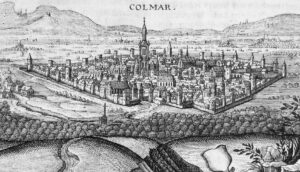
Colmar has a rich and colourful history. It was first mentioned by Charlemagne in his chronicle about the Saxon wars. It was the location where the Carolingian Emperor Charles the Fat held a Diet (Assembly) in 884. Colmar was granted the status of a free imperial city by Emperor Frederick II in 1226, and in 1354, it joined the Décapole City League, which was an alliance of ten Imperial cities of the Holy Roman Empire in the Alsace region to maintain their rights.
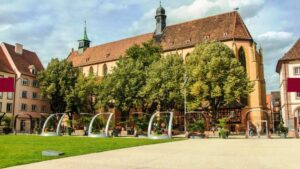
The city adopted the Protestant Reformation in 1575, long after its northern neighbours Strasbourg and Sélestat. It was captured by the Swedish army in 1632, and held for 2 years. In 1634, the Schoeman family arrived and established the first town library. In 1635, Colmar’s harvest was destroyed by Imperialist forces while the citizens shot at them from the city walls. The city was conquered by the French under Louis XIV in 1673, and officially ceded to them in 1679.
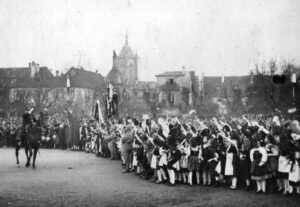
Catastrophe struck In 1854 when a cholera epidemic killed many in the city. With the rest of Alsace, Colmar was ceded to the newly formed German Empire in 1871 after the Franco-Prussian War, and incorporated into the province of Alsace-Lorraine. The Treaty of Versailles returned Colmar to France after WWl, but was annexed by Nazi Germany in 1940, and then reverted to France after the battle of the ‘Colmar Pocket’ in 1945.

There was great excitement in Colmar when a hoard of precious objects, which became known as the Colmar Treasure, thought to have been hidden by Jews during the Black Death, was discovered in 1863. Some items were secretly sold by the discoverers before the full extent of the Treasure could be recorded, and those that survived are mostly in the Musée de Cluny in Paris, but a couple of items are housed in the Unterlinden Museum in Colmar. The Treasure includes silver coins, silver tableware, and gold and silver jewellery including elaborate belt buckles, and 15 silver rings. The collection was exhibited at New York’s Metropolitan Museum of Art in 2019.

The history of Colmar is reflected in the variety of its architecture. Many monuments date from the Middle Ages to the Renaissance, most of which have been finely restored and are listed historic monuments. As well, Colmar is especially famous for its half-timbered houses, many of which were merchants’ homes.
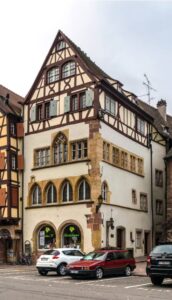
Among so many gems, a couple of them are particularly notable: Maison Adolf in Place de la Cathedrale, the oldest house in Colmar, built around 1350.

The beautiful Maison Pfister in rue des Marchands, built in 1537, distinctive with its two-storey corner oriel, its timber gallery, octagonal turret and its mural paintings representing biblical and secular scenes. Built for a very successful hat-maker, it’s now named after the family who restored it in the 19th century. Both houses have fine architectural details and decorative carvings typical of their eras of construction.
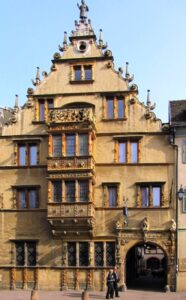
The so-called Maison des Tetes (House of Heads) in rue des Tetes, was built in 1609 during the German Renaissance for a shopkeeper named Anton Burger. The house is attributed to the architect Albert Schmidt, who also designed the former Protestant presbytery and the House of the Knights of St John. The Maison des Tetes owes its name to the 106 heads or grotesque masks, that decorate a rich façade that has a striking three-storey bay window. The building’s gable is decorated with volutes (spiral scrolls), and the statue of a cooper, or maker of barrels and casks, sculpted in 1902 by Auguste Bartholdi, commissioned by the Wine Exchange who had moved into the building in 1898.

Check out the Covered Market in rue des Écoles. A fine metal framed brick building designed in 1865 that has around 20 merchants offering high quality local food products and other delights from the region.
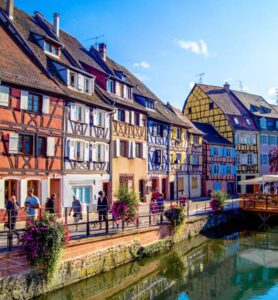
As the name suggests, the Quai de la Poissonnerie was the fishmongers’ district where most of the professional fishermen and boatmen of Colmar lived, and who were a powerful group in the city. The fish they caught were stored in fish ponds or sold in this fishmongers’ district. In 1706, a huge fire destroyed more than 40 houses here, and it wasn’t until 1978-81 that important works took place to restore many of these half-timbered houses. This district lies between the Tanneurs district and the picturesque Little Venice.
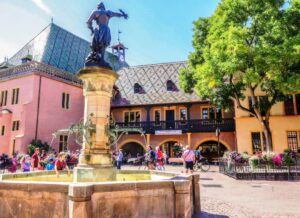
Little Venice is one of the must-visit gems of Colmar—although it bears no resemblance to Venice, aside from having a canal system! Little Venice is the name given to the course of the Lauch River that flows through Colmar, when the river banks were lined with houses along much of its length. The district starts behind the Koifhus (Customs House), and runs through the fishmongers’ district to the Turenne and Saint-Pierre bridges.

The river is at the beginning of the Krutenau, which refers to market gardens on the outskirts of towns. Originally inhabited by a rural community of wine producers, market gardeners and boatmen, the Krutenau area stretches out around the rue Turenne. A very pleasant way to relax is to take a boat ride from here, and discover Colmar from a different perspective, with the many pretty cafes and pedestrian walkways as you glide by.
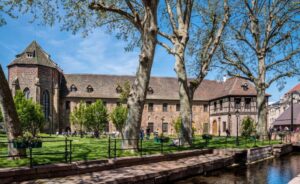
Colmar has a couple of notable museums, the most important of them has to the Unterlinden Museum. The museum was established in 1849 and located in a 13th century Dominican convent that had been abandoned following the Revolution, and a 1906 former public baths building now linked together, plus an additional contemporary extension. An underground gallery consisting of 3 exhibition rooms passes underneath Place Unterlinden and the canal. This leads to the new building, the Ackerhof, which is named after the convent’s former farm building. The collection first centred around a Roman mosaic found in Bergheim, in the Haut-Rhin department in N.E. France, and is still on display.
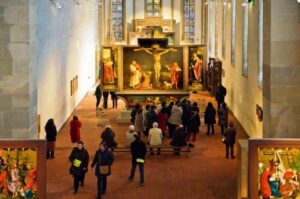
The museum is home to the Isenheim Altarpiece by the German Renaissance painter Matthias Grünewald, and a number of other large painted and/or sculpted altarpieces from former churches, abbeys and monasteries. The museum also has a large collection of local and international works of art, as well as artifacts from prehistoric to contemporary times. There are engravings and woodcuts by Albrecht Dürer and Hans Holbein the Elder, among many others. Many modern artists are also represented, including paintings by Monet, Picasso, Dufy, Dubuffet, Leger, Rouault, Bonnard, and Robert Delaunay, to name a few. This is a very fine museum well worth visiting.
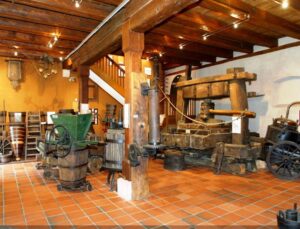
Check out the Alsatian Wine Museum, where you can discover everything you wish to know about the history of Alsatian wines and enjoy tastings. Also the Bartholdi Museum that displays works by the sculptor Auguste Bartholdi as well as family furniture personal souvenirs models, drawings, paintings, engravings and photographs over 3 floors.
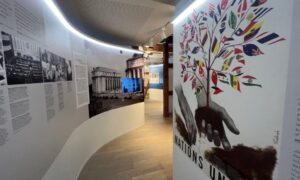
The Schweitzer Centre is dedicated to the universalist message of peace and the humanist principles so dear to Albert Schweitzer, who was born in Kaysersberg, about 11 kms from Colmar. Thanks to modern facilities and the use of digital technologies, visitors can immerse themselves in the world of this great man and discover his ideas through permanent and temporary exhibitions.
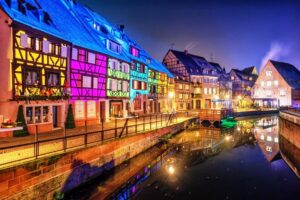
The delights of Colmar are enhanced with magical lighting. 1,100 computer-driven lights, using a fibre optics cable network, are skilfully distributed throughout the town and thus allow an original light show all year round. Like a magic paintbrush, the lighting seems to re-draw the town, applying fresh contours and new reliefs, enhancing a thousand and one architectural details. The town is illuminated from nightfall on Fridays and Saturdays throughout the whole year, and every evening during major events that mark the life of the town, such as the International Festival, Regional Alsace Wine Fair, Musique en Fete and Christmas in Colmar.
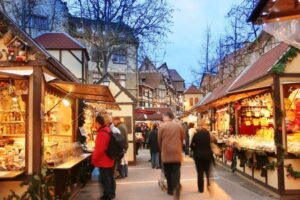
If you are lucky enough to be in France during Christmas, Colmar has to be on your Must Visit list! Its vibrant Christmas markets are justifiably famous. They stretch down cobblestone streets, fill plazas and every available space, and are aglow with twinkling lights at every angle. Dozens of wooden chalets sell unique gifts such as nutcrackers, ornaments and figurines crafted by local artisans. The air is scented with the aromas of mulled wine, candied almonds, roasted chestnuts and glistening gingerbread. You find stalls selling traditional Alsatian snacks like flammekueche (flaming tarts), warmed cheeses and lots of local charcuterie. Stroll through the bustling, festive atmosphere, listening to carol-singers while sipping a steaming mug of mulled wine (vin chaud in French, glühewein in German).
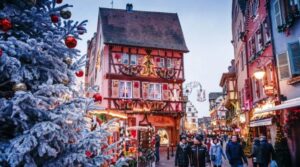
During the day, the markets are slightly less crowded, but there’s much to recommend visiting after dark as well, with the energy of the crowds that truly enhances the experience, as you search out that perfect last minute Christmas gift, while you try various local delicacies and enjoy the pretty lights dotting the canals—a truly magical Christmas experience. In Colmar, the Christmas markets take place from 23 November until 29 December, but the dates can change slightly each year. Best check out the town’s website before you plan dates.
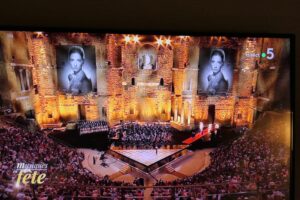
If you’re planning on visiting Colmar in June, try and be there on the 21st, as there is highly regarded Musique en Fete festival held every year at that time.

As you can see, there is so much to see and enjoy in this beautiful town at any time of year– it is truly the gateway to the Alsace!
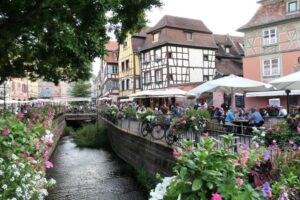


Leave a Reply